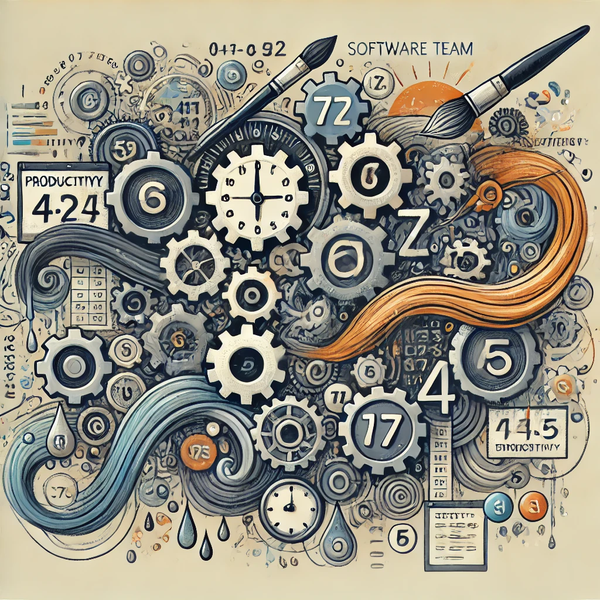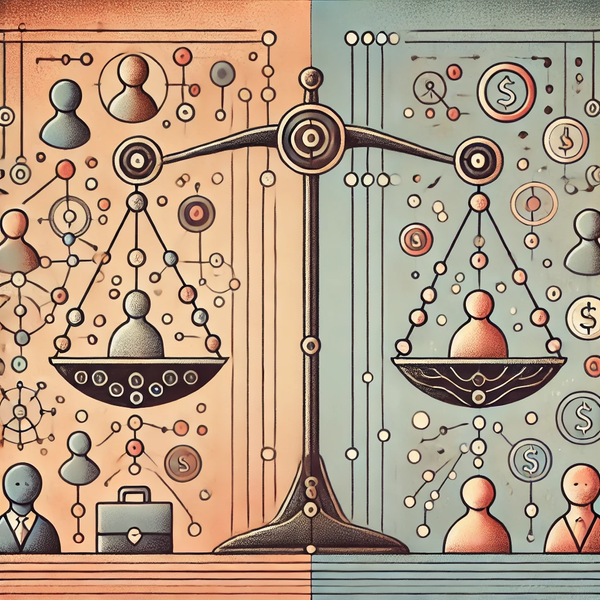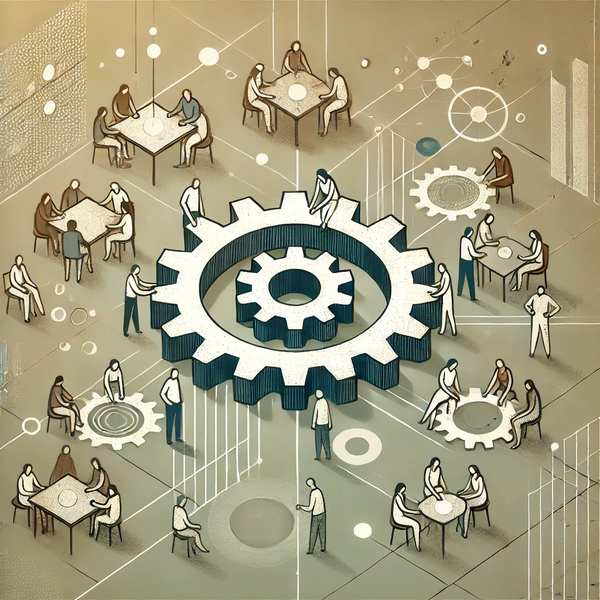
Embedding a Culture of Mutual Aid in your Engineering Organization
Exploring how the principle of generalized reciprocity, where mutual support outweighs individual gain, drives team success—both in organizations and on the soccer field—proving that collaboration truly outshines solo glory.
Building a workplace where mutual aid thrives is about more than promoting collaboration—it's about creating a culture where everyone feels responsible for each other's success. Helping others isn't just a one-off, transactional thing in this environment. Instead, it's a continuous process that benefits the entire team.
Science has well documented these benefits. Generalized reciprocity describes a social dynamic in which acts of support are given freely without expecting anything in return. This dynamic can foster trust, strengthen relationships, and reinforce a collaborative culture in organizations.
In this article, I will review the science and data behind generalized reciprocity, how a culture of mutual aid benefits an organization, and the implementation challenges. Finally, I will give you some ideas on how you can foster these dynamics in your organization.
So, what is generalized reciprocity?
Generalized reciprocity is a form of exchange where acts of giving occur without the immediate expectation of a return. It is an open-ended system of mutual aid, driven by the understanding that support will eventually come back, even if not directly. This idea is central to many anthropological discussions about social cohesion. It is frequently contrasted with "balanced reciprocity," where the exchange is more immediate and explicit, e.g., buying and paying for a service.
In Toward an Anthropological Theory of Value, David Graeber explores how generalized reciprocity operates in non-market economies. He explains that this form of reciprocity is common in close-knit groups, such as families or small communities, where the goal is to maintain long-term relationships rather than settle specific debts. Graeber emphasizes that generalized reciprocity creates a "permanent sense of mutual obligation," which binds people together in a web of social commitments far removed from the transactional nature of market exchanges.
Marshall Sahlins, in Stone Age Economics, further defines generalized reciprocity as a practice where individuals offer help based on their ability, trusting that they will receive similar support in times of need. This form of exchange contrasts with the competitive nature of market interactions, focusing on collective well-being rather than individual gain.
In Anthro-Vision, A New Way to See in Business, Gillian Tett touches on the broader implications of reciprocity within organizations and modern economies. Tett suggests that modern businesses could benefit from understanding these non-monetary exchanges, as they highlight the importance of trust, relationships, and long-term value over short-term gain.
Another way of thinking about it is that generalized reciprocity is the opposite of a competitive, transactional relationship. Generalized reciprocity fosters a culture of support, where individuals contribute based on their ability and rely on others when in need.
This idea can be succinctly expressed in a phrase anyone who has ever participated in team sports has heard many times:
There is no I in Team.
Players contribute to the team's success without expecting an immediate return or individual glory. They may pass the ball, support each other defensively, and make sacrifices for the collective goal of winning, trusting that their teammates will do the same when the time comes. This support and sacrifice are exchanges between the players. They create a system where every player benefits from the team's success, even if individual contributions aren't always immediately rewarded.
When everyone on the team shares responsibility and works toward the common goal, the team becomes more cohesive and effective. A team thrives when each player supports others through strategic passes, defending as a unit, or making runs that open space for others. These actions reflect generalized reciprocity—players give their best for the team's benefit, trusting they will receive support when needed.
Conversely, when a few players try to hoard all the glory by focusing solely on individual achievements, essentially competing within the team, everyone suffers. These players might refuse to pass, overcomplicate plays, or prioritize personal accolades over team success. This self-focus disrupts the game's flow, reduces trust, and can create resentment among their peers. In the long run, this selfish behavior weakens team cohesion, making it harder for the group to work together effectively.
Your software organization is no different. When some members over-contribute and others under-contribute, this imbalance leads to frustration, inefficiency, and ultimately poorer results. If we can focus on general reciprocity and encourage a culture of mutual aid, our organization will experience better outcomes.
The Power of Mutual Aid
We've all seen the impact of mutual aid in real time, especially during crises. Think about how communities came together during the pandemic. Mutual aid systems filled gaps when government and corporate responses couldn't keep up.
In her book Accelerate: The Science of Lean Software and DevOps: Building and Scaling High Performing Technology Organizations, Nicole Forsgren and her co-authors demonstrate the power of mutual aid by focusing on collaboration and trust within high-performing DevOps teams. One clear example is how teamwork and a culture of shared responsibility drive performance. Forsgren's research shows that teams fostering collaboration and building on mutual support can deploy code 30 times more frequently and with 8,000 times faster lead times than lower-performing organizations. These teams also achieve significantly higher reliability, with twice the change success rate and a 12 times more rapid failure recovery.
The key takeaway is that mutual aid helps create a positive feedback loop. When teams support one another, they reduce unplanned work and deployment pain, making work more sustainable. The research highlights how reciprocal support within teams—where everyone takes responsibility for their and others' success—improves job satisfaction, more robust performance, and ultimately better business outcomes.
This data-driven analysis underscores the power of mutual aid in building resilient, high-performing teams. It shows that when mutual support is embedded into organizational culture, it directly contributes to long-term success.
When mutual aid is structured well, it allows people to take ownership and contribute to the whole team's success. This empowerment can lead to more innovative thinking and a more substantial commitment. Forsgren's research backs this up, showing that teams perform better when they trust each other and share responsibility.
But It's Not All Perfect
That said, mutual aid comes with its own set of challenges. One big issue is power dynamics. Even though mutual aid is meant to be egalitarian, it can sometimes reinforce existing inequalities. If you're not careful, mutual aid can become more about obligation and less about support. Those already more powerful can benefit more from the system, leaving others feeling overworked or taken advantage of.
How does this happen? When mutual aid is integrated into an organization's culture, it can sometimes shift from a positive force into an obligation that leads to burnout, particularly if not carefully managed. David Graeber explores this dynamic in Toward an Anthropological Theory of Value. He points out that contributions can transform into unspoken social obligations. People feel pressure to continuously contribute to the community or team, not out of voluntary commitment but because they fear being perceived as selfish or non-cooperative. This sense of obligation can create an imbalance where specific individuals bear the brunt of the workload, fostering resentment and burnout.
Another problem is sustainability. Mutual aid efforts tend to peak during emergencies, but keeping them going once the crisis passes is tough. People get tired, and if the workload isn't spread out evenly and planned out over the long term, the whole system can collapse under the weight of its good intentions.
Nicole Forsgren's research in Accelerate highlights how these dynamics can play out in software teams. Forsgren explains that when mutual aid is embedded into daily operations, it can significantly improve team performance and satisfaction. However, if mutual aid structures aren't sustainable, they can lead to significant stress and burnout. Forsgren's findings show that burnout often arises when a few individuals take on the lion's share of helping others without proper support or distribution of labor, leading to emotional exhaustion.
Tett further emphasizes that organizations typically overlook the social dynamics of mutual aid. Tett suggests that when leaders don't account for continuous support's relational and emotional toll, employees may feel trapped in a cycle of endless giving. This cycle can exacerbate existing power dynamics, where some employees become informal leaders or bear greater responsibilities while others may not feel as pressured to contribute. This uneven distribution harms the well-being of the most active participants and undermines the long-term effectiveness of mutual aid initiatives.
Art Imitates Life
In Gene Kim's The Phoenix Project, the concept of mutual aid is central to the transformation of Parts Unlimited, a company struggling with IT bottlenecks and failing projects. The novel showcases how cross-functional teams can leverage mutual aid to drive efficiency but also warns about the dangers of burnout when collaboration is poorly managed.
One of the primary challenges illustrated in the book is the over-reliance on "Brent," a key IT engineer who becomes the bottleneck for almost every project. Brent is highly skilled, and teams across the company constantly seek his help to fix problems or provide expertise. While this is an example of mutual aid in action—where Brent supports different teams—this informal system leads to burnout. Brent becomes overwhelmed by requests and unable to focus on his tasks. His workload is unmanageable, and his involvement in every critical issue stalls progress across the organization.
The dependence on Brent reflects a common issue in organizations: mutual aid systems are too dependent on a few key individuals. When certain employees are seen as the go-to problem-solvers, this creates an unsustainable burden, leading to stress, burnout, and a negative impact on individual and team performance.
The turning point in The Phoenix Project comes when the leadership realizes that relying on Brent for everything is unsustainable. To address this, the company adopts a more systematic approach to mutual aid by emphasizing knowledge sharing and cross-training. This shift involves:
- Distributing expertise across the team: Instead of relying on Brent for every solution, the company implements processes that allow other team members to learn the skills and knowledge needed to handle issues. By cross-training employees, the organization reduces dependence on a single individual and spreads the workload more evenly.
- Creating repeatable processes: Another critical solution is automating repetitive tasks and implementing standardized processes so Brent and others in crucial roles don't constantly have to fix the same issues. The team eliminates unplanned work that consumes time and energy by introducing automation.
- Building more robust communication channels: The company fosters collaboration between development, operations, and security teams by encouraging them to work together more closely. This ensures that the entire team, not just a few individuals, is involved in problem-solving.
This shift in approach transforms Parts Unlimited's work culture from crisis-driven dependency on a few individuals to a system where mutual aid is sustainable. By building a culture of shared responsibility, the company avoids burnout while still leveraging the collective strength of its teams. Mutual aid remains a core value, but it's supported by clear processes and distributed expertise, ensuring no one person is overwhelmed.
The lesson from The Phoenix Project is that mutual aid needs structure to be effective in the long term. By distributing responsibility, sharing knowledge, and creating systems that reduce the burden on individuals, organizations can foster a culture of collaboration without leading to burnout. These actions mirror principles in successful DevOps practices where cross-functional teams work together to solve problems, share expertise, and improve workflows.
Finding the Right Balance
So, how do you make mutual aid work in your organization without falling into these traps? It's all about balance. Encouraging mutual aid doesn't mean sacrificing individual achievements. Instead, it's about creating a culture where helping others leads to shared success. Forsgren's research shows that when organizations align mutual aid efforts with their core mission and goals, they can avoid the pitfalls of burnout and exploitation while reaping the benefits of a collaborative, high-trust environment.
In Accelerate, Nicole Forsgren discusses how companies like Google have structured mutual aid systems within their teams to avoid burnout. Google's 20% time policy allows employees to spend 20% of their workweek on projects that interest them, contributing to their personal development and the company's goals. This structured time for creativity and experimentation helps prevent burnout by ensuring employees are not continuously overburdened with their regular tasks, allowing them to engage in meaningful work while contributing to collective success. Another significant source of burnout is deployment pain. Organizations can address this source of burnout by implementing lean practices and having a continuous delivery focus. These practices allow teams to support each other by simplifying complex deployments and eliminating the after-hours burdens that lead to stress and exhaustion.
From an anthropological perspective, Gillian Tett in Anthro-Vision highlights how companies that actively create space for social bonds and mutual support can thrive without overloading individuals. For example, companies that focus on diversity of thought and ensure their teams are culturally aligned reduce burnout by fostering a sense of belonging and collective achievement rather than isolating individuals in high-stress environments. Tett emphasizes the importance of recognizing social dynamics within companies, suggesting that leaders must know the informal expectations placed on employees. When mutual aid systems fail to consider these dynamics, certain employees may feel overburdened with unacknowledged responsibilities, leading to burnout.
It can be challenging, but it is worth it
Mutual aid has the power to transform organizational culture by fostering collaboration, trust, and shared responsibility, but its success hinges on thoughtful design and careful balance.
Forsgren's research demonstrates how high-performing organizations, especially in DevOps, thrive when they foster mutual aid in a structured way. Teams that support one another and embed mutual trust into their processes deploy code faster, with fewer failures, and enjoy greater job satisfaction. However, Forsgren also highlights the risks of burnout when these systems are unmanaged. Sustainable mutual aid requires deliberate workload distribution and process automation to prevent key individuals from becoming bottlenecks, a lesson demonstrated in The Phoenix Project.
Tett broadens the lens, showing how companies that understand the anthropological principles of reciprocity and social dynamics can create environments where mutual aid thrives without becoming burdensome. Tett underscores that organizations must be aware of informal social obligations that may arise when mutual aid becomes an unspoken expectation, which can lead to inequality and burnout if not checked. She argues that by recognizing and managing these dynamics, businesses can create a culture where everyone participates equally and is supported, avoiding the traps of over-reliance on specific individuals.
In Software Engineering at Google: Lessons Learned from Programming Over Time, Titus Winters adds another dimension to the discussion by emphasizing Google's knowledge sharing and cross-functional collaboration. Google avoids the pitfalls of burnout by ensuring that no single individual becomes indispensable. Instead, the company emphasizes systems that enable employees to share knowledge across teams, which helps prevent the overburdening of key staff. This approach reflects the broader principle that mutual aid should empower teams collectively rather than concentrate responsibility in the hands of a few. Google's culture also encourages automation to eliminate repetitive tasks, freeing team members to focus on higher-value work, further reducing the risk of burnout.
Key Takeaways
To summarize, we can take away the following advice:
Structured mutual aid fosters high performance: As Forsgren's research in Accelerate shows, organizations that structure mutual aid effectively see faster delivery times, fewer failures, and greater team satisfaction.
Cross-training and knowledge sharing reduce burnout: In Software Engineering at Google, distributed responsibility and shared expertise prevent teams from over-relying on specific individuals, ensuring that mutual aid does not become a burden.
- Awareness of social dynamics is crucial: Tett's work in Anthro-Vision illustrates that organizations must be conscious of the social obligations and power dynamics that can emerge from informal mutual aid systems. Addressing these challenges can create a more equitable and sustainable collaborative environment.
Final Thoughts
Fostering mutual aid within organizations leads to more resilient, adaptable teams, but leaders must do this thoughtfully. By structuring mutual assistance, sharing knowledge, and recognizing the social dynamics at play, organizations can ensure that collaboration doesn't lead to burnout or inequality.
Successful organizations build systems that empower everyone to contribute while maintaining sustainable workloads and equitable participation. The result is a culture of trust, shared success, and long-term resilience.




